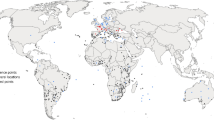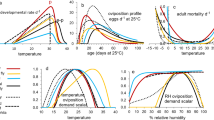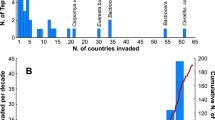Abstract
Climate change affects the rate of insect invasions as well as the abundance, distribution and impacts of such invasions on a global scale. Among the principal analytical approaches to predicting and understanding future impacts of biological invasions are Species Distribution Models (SDMs), typically in the form of correlative Ecological Niche Models (ENMs). An underlying assumption of ENMs is that species–environment relationships remain preserved during extrapolations in space and time, although this is widely criticised. The semi-mechanistic modelling platform, CLIMEX, employs a top-down approach using species ecophysiological traits and is able to avoid some of the issues of extrapolation, making it highly applicable to investigating biological invasions in the context of climate change. The tephritid fruit flies (Diptera: Tephritidae) comprise some of the most successful invasive species and serious economic pests around the world. Here we project 12 tephritid species CLIMEX models into future climate scenarios to examine overall patterns of climate suitability and forecast potential distributional changes for this group. We further compare the aggregate response of the group against species-specific responses. We then consider additional drivers of biological invasions to examine how invasion potential is influenced by climate, fruit production and trade indices. Considering the group of tephritid species examined here, climate change is predicted to decrease global climate suitability and to shift the cumulative distribution poleward. However, when examining species-level patterns, the predominant directionality of range shifts for 11 of the 12 species is eastward. Most notably, management will need to consider regional changes in fruit fly species invasion potential where high fruit production, trade indices and predicted distributions of these flies overlap.





Similar content being viewed by others
References
Aluja M, Mangan RL (2008) Fruit fly (Diptera: Tephritidae) host status determination: critical conceptual, methodological, and regulatory considerations. Annu Rev Entomol 53:473–502
Austin MP, Van Niel KP (2011) Improving species distribution models for climate change studies: variable selection and scale. J Biogeogr 38:1–8
Bacon SJ, Aebi A, Calanca P, Bacher S (2014) Quarantine arthropod invasions in Europe: the role of climate, hosts and propagule pressure. Divers Distrib 20:84–94
Baker RHA, Sansford CE, Jarvis CH, Cannon RJC, MacLeod A, Walters KFA (2000) The role of climatic mapping in predicting the potential geographical distribution of non-indigenous pests under current and future climates. Agric Ecosyst Environ 82:57–71
Bale JS, Masters GJ, Hodkinson ID, Awmack C et al (2002) Herbivory in global climate change research: direct effects of rising temperature on insect herbivores. Glob Change Biol 8:1–16
Barton MG, Terblanche JS (2014) Predicting performance and survival across topographically heterogeneous landscapes: the global pest insect Helicoverpa armigera (Hübner, 1808) (Lepidoptera: Noctuidae). Austral Entomol 53:249–258
Baselga A (2010) Partitioning the turnover and nestedness components of beta diversity. Glob Ecol Biogeogr 19:134–143
Bebber DP, Ramotowski MAT, Gurr SJ (2013) Crop pests and pathogens move polewards in a warming world. Nat Clim Change 3:985–988
Bertelsmeier C, Luque GM, Courchamp F (2013a) Increase in quantity and quality of suitable areas for invasive species as climate changes. Conserv Biol 27:1458–1467
Bertelsmeier C, Luque GM, Courchamp F (2013b) The impact of climate change changes over time. Biol Conserv 16:107–115
Bertelsmeier C, Luque GM, Hoffmann BD, Courchamp F (2015) Worldwide ant invasions under climate change. Biodivers Conserv 24:117–128
Bishop T, Robertson MP, van Rensburg BJ, Parr CL (2015) Contrasting species and functional beta diversity in montane ant assemblages. J Biogeogr 42:1776–1786
Brook BW, Sodhi NS, Bradshaw CJA (2008) Synergies among extinction drivers under global change. Trends Ecol Evol 23:453–460
Chown SL, Slabber S, McGeoch MA, Janion C, Leinaas HP (2007) Phenotypic plasticity mediates climate change responses among invasive and indigenous arthropods. Proc R Soc B 274:2531–2537
De Meyer M, Robertson MP, Peterson AT, Mansell MW (2008) Ecological niches and potential geographical distributions of Mediterranean fruit fly (Ceratitis capitata) and Natal fruit fly (Ceratitis rosa). J Biogeogr 35:270–281
de Villiers M, Hattingh V, Kriticos DJ (2013) Combining field phenological observations with distribution data to model the potential distribution of the fruit fly Ceratitis rosa Karsch (Diptera: Tephritidae). Bull Entomol Res 103:60–73
Delean S, Bull CM, Brook BW, Heard LMB, Fordham DA (2013) Using plant distributions to predict the current and future range of a rare lizard. Divers Distrib 19:1125–1137
Desurmont GA, Pearse IS (2014) Alien plants versus alien herbivores: does it matter who is non-native in a novel trophic interaction? Curr Opin Insect Sci 2:20–25
Dukes JS, Pontius J, Orwig D et al (2009) Responses of insect pests, pathogens, and invasive plant species to climate change in the forests of northeastern North America: What can we predict? Can J For Res 39:231–248
Duyck PF, David P, Quilici S (2004) A review of relationships between interspecific competition and invasions in fruit flies (Diptera: Tephritidae). Ecol Entomol 29:511–520
Duyck PF, David P, Quilici S (2007) Can more K-selected species be better invaders? A case study of fruit flies in La Réunion. Divers Distrib 13:535–543
Elith J, Leathwick JR (2009) Species distribution models: ecological explanation and prediction across space and time. Annu Rev Ecol Syst 40:677–697
FAO (Food and Agriculture Organization of the United Nations) Statistics Division Database. http://faostat3.fao.org/download/Q/QC/E. Accessed July 2015
Fitzpatrick MC, Weltzin JF, Sanders N et al (2007) The biogeography of prediction error: why does the introduced range of the fire ant over-predict its native range? Glob Ecol Biogeogr 16:24–33
Fu L, Li ZH, Huang GS, Wu XX, Ni WL, Qü WW (2014) The current and future potential geographic range of West Indian fruit fly, Anastrepha obliqua (Diptera: Tephritidae). Insect Sci 21:234–244
Geng J, Li ZH, Rajotte EG, Wan FH, Lu XY, Wang ZL (2011) Potential geographical distribution of Rhagoletis pomonella (Diptera: Tephritidae) in China. Insect Sci 18:575–582
Gibert P, Hill MP, Pascual M, Plantamp C, Terblanche JS (2016) Drosophila as models to understand the adaptive process during invasion. Biol Invasions. doi:10.1007/s10530-016-1087-4
Gutierrez AP, Ponti L (2014) Analysis of invasive insects: links to climate change. In: Ziska L, Dukes J (eds) Invasive species and global climate change. CABI, Croydon, pp 45–61
Harrington R, Clark SJ, Welham SJ et al (2007) Environmental change and the phenology of European aphids. Glob Change Biol 13:1550–1564
Hellmann JJ, Byers JE, Bierwagen BG, Dukes JS (2008) Five potential consequences of climate change for invasive species. Conserv Biol 22:534–543
Hijmans RJ (2015) Raster: geographic data analysis and modeling. R package version 2.3-40. http://CRAN.R-project.org/package=raster
Hijmans RJ, Phillips S, Leathwick J, Elith J (2015) Package ‘dismo’—species distribution modelling. R package version 1.0–12 http://cran.r-project.org/web/packages/dismo/index.html
Hill MP, Terblanche JS (2014) Niche overlap of congeneric invaders supports a single-species hypothesis and provides insight into future invasion risk: implications for global management of the Bactrocera dorsalis complex. PLoS One 9:e90121. doi:10.1371/journal.pone.0090121
Hill MP, Chown SL, Hoffmann AA (2013) A predicted niche shift corresponds with increased thermal resistance in an invasive mite, Halotydeus destructor. Glob Ecol Biogeogr 22:942–951
Hill MP, Axford JK, Hoffmann AA (2014) Predicting the spread of Aedes albopictus in Australia under current and future climates: multiple approaches and datasets to incorporate potential evolutionary divergence. Aust Ecol 39:469–478
IPCC (2007) Climate change 2007: the physical science basis. In: Solomon S, Qin D, Manning M, Chen Z, Marquis M, Averyt KB, Tignor M, Miller HL (eds) Contribution of working group i to the fourth assessment report of the intergovernmental panel on climate change. Cambridge University Press, Cambridge
Jian G, Zhihong L, Fanghao W, Zhiling W (2008) Analysis of the suitability of Mexican fruit fly, Anastrepha ludens in China. Plant Prot 4:024
Jiménez-Valverde A, Peterson AT, Soberón J, Overton JM, Aragón P, Lobo JM (2011) Use of niche models in invasive species risk assessments. Biol Invasions 13:2785–2797
Karsten M, Jansen van Vuuren B, Addison P, Terblanche JS (2015) Deconstructing intercontinental invasion pathway hypotheses of the Mediterranean fruit fly (Ceratitis capitata) using a Bayesian inference approach: are port interceptions and quarantine protocols successfully preventing new invasions? Divers Distrib 21:813–825
Kriticos DJ, Leriche A (2010) The effects of climate data precision on fitting and projecting species niche models. Ecography 33:115–127
Kriticos DJ, Webber BL, Leriche A, Ota N, Macadam I, Bathols J, Scott JK (2012) CliMond: global high-resolution historical and future scenario climate surfaces for bioclimatic modelling. Methods Ecol Evol 3:53–64
Kumar S, Neven LG, Yee WL (2014) Assessing the potential for establishment of western cherry fruit fly using ecological niche modeling. J Econ Entomol 107:1032–1044
Lantschner MV, Villacide JM, Garnas JR, Croft P, Carnegie AJ, Liebhold AM, Corley JC (2014) Temperature explains variable spread rates of the invasive woodwasp Sirex noctilio in the Southern Hemisphere. Biol Invasions 16:329–339
Lenoir J, Svenning JC (2015) Climate-related range shifts—a global multidimensional synthesis and new research directions. Ecography 38:15–28
Liebhold AM, Work TT, McCullough DG, Cavey JF (2006) Airline baggage as a pathway for alien insect species invading the United States. Am Entomol 52:48–54
Liebhold AM, Yamanaka T, Roques A, Augustin S, Chown SL, Brockerhoff EG, Pyšek P (2016) Global compositional variation among native and non-native regional insect assemblages emphasizes the importance of pathways. Biol Invasions. doi:10.1007/s10530-016-1079-4
Lingbin K, Wei L, Zhong L, Fanghao W, Zhiling W, Guansheng H (2008) A predication of potential geographic distribution of melon fruit fly based on CLIMEX and DIVA-GIS. Acta Phytophylacica Sin 2:010
Lozier JD, Mills NJ (2011) Predicting the potential invasive range of light brown apple moth (Epiphyas postvittana) using biologically informed and correlative species distribution models. Biol Invasions 13:2409–2421
Lu W, Yuliang D, Li Z, Wei L, Fanghao A, Zhiling W (2010) A prediction of potential geographical distribution of guava fruit fly, Bactrocera (Bactrocera) correcta (Bezzi) in China. Acta Phytophylacica Sin 6:010
Ma X, Li Z, Ni W, Qu W, Wu J, Wan F, Hu X (2012) The current and future potential geographical distribution of the solanum fruit fly Bactrocera latifrons (Diptera: Tephritidae) in China. In: Li D, Chen Y (eds) Computer and computing technologies in agriculture V. Springer, Berlin, pp 236–246
Macfadyen S, Kriticos DJ (2012) Modelling the geographical range of a species with variable life-history. PLoS One 7:e40313. doi:10.1371/journal.pone.0040313
Manrakhan A, Hattingh V, Venter JH, Holtzhausen M (2011) Eradication of Bactrocera invadens (Diptera: Tephiritidae) in Limpopo province, South Africa. African Entomol 19:650–659
Mika AM, Newman JA (2010) Climate change scenarios and models yield conflicting predictions about the future risk of an invasive species in North America. Agr For Entomol 12:213–221
Ni WL, Li ZH, Chen HJ, Wan FH, Qu WW, Zhang Z, Kriticos DJ (2012) Including climate change in pest risk assessment: the peach fruit fly, Bactorcera zonata (Diptera: Tephritidae). Bull Entomol Res 102:173–183
Nuñez MA, Pauchard A (2010) Biological invasions in developing and developed countries: does one model fit all? Biol Invasions 12:707–714
Papadopoulos NT, Plant RE, Carey JR (2013) From trickle to flood: the large-scale, cryptic invasion of California by tropical fruit flies. Proc R Soc B 280:20131466. doi:10.1098/rspb.2013.1466
Patz JA, Campbell-Lendrum D, Holloway T et al (2005) Impact of regional climate change on human health. Nature 438:310–317
Pearson RG, Dawson TP (2003) Predicting the impacts of climate change on the distribution of species: are bioclimate envelope models useful? Glob Ecol Biogeogr 12:361–371
Pebesma EJ, RS Bivand (2005). Classes and methods for spatial data in R. R News 5 (2). http://cran.r-project.org/doc/Rnews/
R Core Team (2015) R: a language and environment for statistical computing. R Foundation for Statistical Computing, Vienna, Austria. http://www.R-project.org/
Schutze MK, Aketarawong N, Amornsak W et al (2015) Synonymization of key pest species within the Bactrocera dorsalis species complex (Diptera: Tephritidae): taxonomic changes based on a review of 20 years of integrative morphological, molecular, cytogenetic, behavioural and chemoecological data. Syst Entomol 40:456–471
Stephens AEA, Kriticos DJ, Leriche A (2007) The current and future potential geographical distribution of the oriental fruit fly, Bactrocera dorsalis (Diptera: Tephritidae). Bull Entomol Res 97:369–378
Sutherst RW, Maywald GF (1985) A computerised system for matching climates in ecology. Agric Ecosyst Environ 13:281–299
Sutherst RW, Maywald GF (2005) A climate model of the red imported fire ant, Solenopsis invicta Buren (Hymenoptera: Formicidae): implications for invasion of new regions, particularly Oceania. Environ Entomol 34:317–335
Sutherst RW, Maywald GF, Bourne AS (2007) Including species interactions in risk assessments for global change. Glob Change Biol 13:1–17
Synes NW, Osborne PE (2011) Choice of predictor variables as a source of uncertainty in continental-scale species distribution modelling under climate change. Glob Ecol Biogeogr 20:904–914
Taylor S, Kumar L (2012) Sensitivity analysis of CLIMEX parameters in modelling potential distribution of Lantana camara L. PLoS One 7:e40969
Thuiller W (2007) Biodiversity: climate change and the ecologist. Nature 448:550–552
Tscharntke T, Klein AM, Kruess A, Steffan-Dewenter I, Thies C (2005) Landscape perspectives on agricultural intensification and biodiversity-ecosystem service management. Ecol Lett 8:857–874
Vera MT, Rodriguez R, Segura DF, Cladera JL, Sutherst RW (2002) Potential geographical distribution of the Mediterranean fruit fly, Ceratitis capitata (Diptera: Tephritidae), with emphasis on Argentina and Australia. Environ Entomol 31:1009–1022
Virgilio M, Jordaens K, Verwimp C, White IM, De Meyer M (2015) Higher phylogeny of frugivorous flies (Diptera, Tephritidae, Dacini): localised partition conflicts and a novel generic classification. Mol Phylogenet Evol 85:171–179
Walther GR, Roques A, Hulme PE et al (2009) Alien species in a warmer world: risks and opportunities. Trends Ecol Evol 24:686–693
Ward NL, Masters GJ (2007) Linking climate change and species invasion: an illustration using insect herbivores. Glob Change Biol 13:1605–1615
Webber BL, Yates CJ, Le Maitre DC et al (2011) Modelling horses for novel climate courses: insights from projecting potential distributions of native and alien Australian acacias with correlative and mechanistic models. Divers Distrib 17:978–1000
Yamanaka T, Morimoto N, Nishida GM, Kiritani K, Moriya S, Liebhold AM (2015) Comparison of insect invasions in North America. Biol Invasions, Japan and their Islands. doi:10.1007/s10530-015-0935-y
Yonow T, Sutherst RW (1998) The geographical distribution of the Queensland fruit fly, Bactrocera (Dacus) tryoni, in relation to climate. Aust J Agric Res 49:935–953
Ziska LH, Blumenthal DM, Runion GB, Hunt ER Jr, Diaz-Soltero H (2011) Invasive species and climate change: an agronomic perspective. Clim Change 105:13–42
Acknowledgments
The paper had its origin at a workshop on “Drivers, impacts, mechanisms and adaptation in insect invasions” hosted by the DST-NRF Centre of Excellence for Invasion Biology in Stellenbosch, South Africa, in November 2014. Additional financial support was provided by HortGro, the National Research Foundation of South Africa, Stellenbosch University, and SubTrop.
Author information
Authors and Affiliations
Corresponding author
Additional information
Guest editors: Matthew P. Hill, Susana Clusella-Trullas, John S. Terblanche & David M. Richardson / Insect Invasions
Electronic supplementary material
Below is the link to the electronic supplementary material.
Rights and permissions
About this article
Cite this article
Hill, M.P., Bertelsmeier, C., Clusella-Trullas, S. et al. Predicted decrease in global climate suitability masks regional complexity of invasive fruit fly species response to climate change. Biol Invasions 18, 1105–1119 (2016). https://doi.org/10.1007/s10530-016-1078-5
Received:
Accepted:
Published:
Issue Date:
DOI: https://doi.org/10.1007/s10530-016-1078-5




